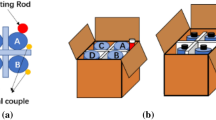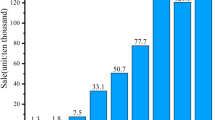Abstract
Preventing thermal runaway propagation is critical to improve the fire safety of electric vehicles. Experiments are conducted on the designed battery modules to study the effects of aerogel, liquid cooling plate, and their combination on the prevention mechanism of thermal runaway propagation. The characteristics of temperature, voltage, mass loss, and venting during the thermal runaway propagation process are compared and analyzed. The results indicate that: (1) adding the insulation material of aerogel can postpone the thermal runaway propagation, but may not completely cut-off the propagation process; (2) there is no obvious delay of thermal runaway propagation by adding the liquid cooling plate only, the propagation speed may be accelerated instead; (3) the thermal runaway propagation can be prevented by using aerogel and liquid cooling plate together. The study reminds us that safety design of battery thermal management system should consider the comprehensive heat transfer pathways in order to effectively prevent thermal runaway propagation.


















Similar content being viewed by others
References
Han X, Ouyang M, Lu L et al (2014) A comparative study of commercial lithium ion battery cycle life in electrical vehicle: aging mechanism identification. J Power Sources 251:38–54
Jaewan K, Jinwoo O et al (2019) Review on battery thermal management system for electric vehicles. Appl Therm Eng 149:192–212
Lamb J, Orendorff C et al (2015) Failure propagation in multi cell lithium ion batteries. J Power Sources 283:517–523
Zheng Y, Gao W et al (2019) An accurate parameters extraction method for a novel on-board battery model considering electrochemical properties. J Energy Storage 24:100745
Ren D, Feng X et al (2017) An electrochemical-thermal coupled overcharge-to-thermal-runaway model for lithium ion battery. J Power Sources 364:328–340
Chen K, Wang S et al (2017) Configuration optimization of battery pack in parallel air-cooled battery thermal management system using an optimization strategy. Appl Therm Eng 123:177–186
Lu L, Han X et al (2013) A review on the key issues for lithium-ion battery management in electric vehicles. J Power Sources 226:272–288
Wang Q, Jinhua S et al (2005) Lithium ion battery fire and explosion. Fire Saf Sci 8:375–382
Huo Y, Rao Z, Liu X et al (2015) Investigation of power battery thermal management by using mini-channel cold plate. Energy Convers Manag 89:387–395
Lan C, Xu J, Qiao Y et al (2016) Thermal management for high power lithium-ion battery by minichannel aluminum tubes. Appl Therm Eng 101:284–292
Zhang T, Gao Q, Wang G et al (2017) Investigation on the promotion of temperature uniformity for the designed battery pack with liquid flow in cooling process. Appl Therm Eng 116:655–662
Jin L, Lee P, Kong X et al (2014) Ultra-thin minichannel LCP for EV battery thermal management. Appl Energy 113:1786–1794
Feng X et al (2015) Characterization of penetration induced thermal runaway propagation process within a large format lithium ion battery module. J Power Sources 275:261–273
Feng X, He X et al (2015) Thermal runaway propagation model for designing a safer battery pack with 25Ah LiNixCoyMnzO2 large format lithium ion battery. Appl Energy 154:74–91
Man C, Sun Q, Li Y et al (2015) A thermal runaway simulation on a lithium titanate battery and the battery module. Energies 8:490–500
Wilke S, Schweitzer B et al (2017) Preventing thermal runaway propagation in lithium ion battery packs using a phase change composite material: an experimental study. J Power Sources 340:51–59
Xu J, Lan C et al (2017) Prevent thermal runaway of lithium-ion batteries with minichannel cooling. Appl Therm Eng 110:883–890
Mohammed A, Esmaeeli R et al (2019) Dual-purpose cooling plate for thermal management of prismatic lithium-ion batteries during normal operation and thermal runaway. Appl Therm Eng 160:114106
Feng X et al (2014) Thermal runaway features of large format prismatic lithium ion battery using extended volume accelerating rate calorimetry. J Power Sources 255:294–301
Frackowiak E, Beguin F et al (2001) Carbon materials for the electrochemical storage of energy in capacitors. Carbon 39:937–950
Feng X, Ouyang M et al (2018) Thermal runaway mechanism of lithium ion battery for electric vehicles: a review. Energy Storage Mater 10:246–267
Wang Q, Ping P, Zhao X, Chu G, Sun J, Chen C (2012) Thermal runaway caused fire and explosion of lithium ion battery. J Power Sources 208:210–224
Dubaniewicz TH, DuCarme JP (2013) Are lithium ion cells intrinsically safe. IEEE Trans Ind Appl 49:2451–2460
Dubaniewicz TH, DuCarme JP (2014) Further study of the intrinsic safety of internally shorted lithium and lithium-ion cells within methane-air. J Loss Prev Process Ind 32:165–173
Li W, Wang H, Ouyang M et al (2019) Theoretical and experimental analysis of the lithium-ion battery thermal runaway process based on the internal combustion engine combustion theory. Energy Convers Manag 185:211–222
Acknowledgements
This work is supported by the Ministry of Science and Technology of China (Grant No. 2019YFE0100200); The National Natural Science Foundation of China (Grant Nos. 51706117 and 51775179); The China Postdoctoral Science Foundation (2019T120087 and 2017M610086). The first author thanks the support of “Young Elite Scientist Sponsorship Program” from China Association for Science and Technology (Grant No. 2018QNRC001).
Author information
Authors and Affiliations
Corresponding author
Rights and permissions
About this article
Cite this article
Yang, X., Duan, Y., Feng, X. et al. An Experimental Study on Preventing Thermal Runaway Propagation in Lithium-Ion Battery Module Using Aerogel and Liquid Cooling Plate Together. Fire Technol 56, 2579–2602 (2020). https://doi.org/10.1007/s10694-020-00995-x
Received:
Accepted:
Published:
Issue Date:
DOI: https://doi.org/10.1007/s10694-020-00995-x




